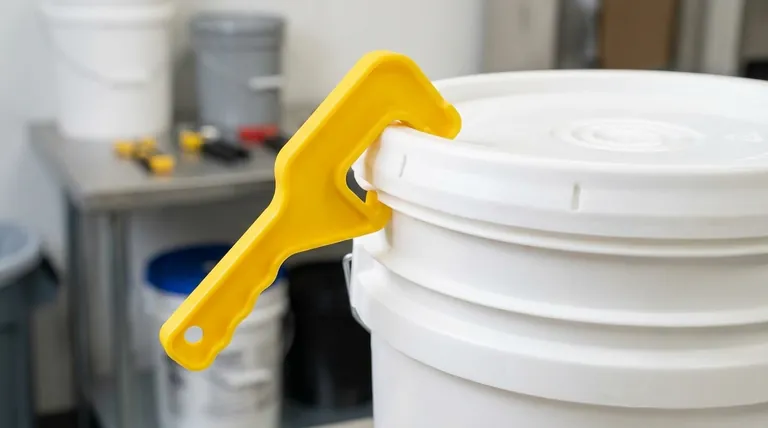A bucket opener is a handheld tool specifically engineered to remove tightly sealed lids from plastic pails and buckets. Its primary function is to provide a significant mechanical advantage, allowing a user to pry open a stubborn lid with minimal effort, reducing the risk of injury and preventing damage to the lid or the bucket itself.
The true purpose of a bucket opener is not simply to open a container, but to do so in a way that preserves the integrity of the lid's seal, protects the user from strain, and ensures the contents remain uncontaminated.

The Problem with Tightly Sealed Buckets
Industrial and food-grade buckets are designed with exceptionally tight seals. This is a feature, not a flaw, intended to prevent spills and protect contents from exposure. However, this design creates significant challenges for opening.
The Risk of Lid and Bucket Damage
Attempting to open these lids with improper tools like screwdrivers or pliers often concentrates force on one small point. This can easily crack, warp, or tear the plastic lid, rendering it unable to properly reseal.
The Danger of Personal Injury
Forcefully prying or pulling on a sealed lid without proper leverage can lead to strained wrists, back injuries, or cuts if the tool slips. The effort required can be surprisingly high and poses a genuine workplace hazard.
The Threat to Product Integrity
For industries like foodservice or chemicals, a damaged lid is a critical failure. A compromised seal allows air, moisture, dust, and bacteria to contaminate the contents, potentially making them unsafe for use or consumption.
How a Bucket Opener Provides the Solution
A bucket opener is a simple yet effective device that directly counters these problems through its specialized design.
Leveraging Mechanical Advantage
The tool features a hook that grips the underside of the lid's rim and a long handle that acts as a lever. This design multiplies the user's force, making it easy to pop the seal with a gentle, controlled motion.
Preserving the Seal
By distributing pressure evenly along the tool's contact point, a bucket opener lifts the lid without causing the stress fractures or warping associated with makeshift methods. This means the lid can be securely resealed for future use.
Ensuring User Safety and Efficiency
Using the correct tool for the job drastically reduces the physical strain required. This not only prevents injuries but also saves time and energy, improving operational efficiency in environments where many buckets are opened daily.
Best Practices for Effective Use
While simple, using the tool correctly ensures the best results and maximizes its benefits.
Position the Tool Correctly
Ensure the opener's hook is firmly seated under the lid's edge before applying any pressure. A secure grip is essential for a clean lift.
Apply Steady, Even Pressure
Avoid sudden, jerking motions. A smooth, steady pull on the handle will pop the seal cleanly without causing the tool to slip or damaging the plastic.
Inspect and Maintain Your Equipment
After opening, briefly inspect the lid and its gasket to ensure no damage has occurred. In food-contact settings, it is critical to clean and sanitize the bucket opener regularly to prevent cross-contamination.
Making the Right Choice for Your Goal
Deciding if you need a bucket opener depends entirely on your context and priorities.
- If your primary focus is commercial efficiency and safety: This tool is an essential investment for any operation that frequently handles sealed pails, such as in foodservice, construction, or manufacturing.
- If your primary focus is preserving product integrity: For any application involving food, paint, or chemicals, a bucket opener is non-negotiable for maintaining a secure, contaminant-free seal.
- If your primary focus is occasional home or workshop use: It is a low-cost convenience that prevents frustration, protects your hands, and extends the life of your reusable buckets.
Ultimately, a bucket opener transforms a potentially difficult and hazardous task into a safe, simple, and professional action.
Summary Table:
| Aspect | Without a Bucket Opener | With a Bucket Opener |
|---|---|---|
| Lid & Bucket | Risk of cracks, warping, and tears | Lid is lifted cleanly, seal remains intact |
| User Safety | High risk of strain, slips, and cuts | Safe, effortless operation with minimal force |
| Product Integrity | Seal can be compromised, leading to contamination | Contents remain sealed and protected from contaminants |
| Efficiency | Time-consuming and physically demanding | Quick, easy, and professional |
Upgrade your operation with professional-grade tools from HONESTBEE.
For commercial apiaries and beekeeping equipment distributors, maintaining product integrity and operator safety is paramount. A bucket opener is essential for safely accessing supplies like sugar syrup, foundation wax, or chemicals without damaging the container's seal.
HONESTBEE supplies durable, wholesale-focused beekeeping supplies and equipment designed for the demands of commercial operations. Ensure your team works efficiently and safely.
Contact HONESTBEE today to discuss your wholesale needs and discover how our equipment can support your business.
Visual Guide

Related Products
- 5 Gallon Pail Opener Bucket Opener Tool for Honey Bucket
- 8-Frame Electric Self-Reversing Honey Extractor Spinner for Commercial Honey Extraction Equipment
- Classic Drum Shaped Glass Honey Jar with Airtight Lid
- 10L Stainless Steel Electric Honey Press Machine
- Honey Wax Separating Wax Press with Metal Screw Wax Separator Machine
People Also Ask
- How do bees produce honey? The Ingenious Process of Natural Food Preservation
- Can a bucket opener work on any type of plastic lid? Unlock the Secrets to Easy Pail Opening
- How does a bucket opener contribute to food safety and product quality? Ensure a Clean, Contaminant-Free Seal Break
- Why are hive inspection tools important for beekeepers? Essential for Safe & Efficient Hive Management
- Why are bucket openers important for efficiency and safety? Boost Speed & Protect Your Products



















